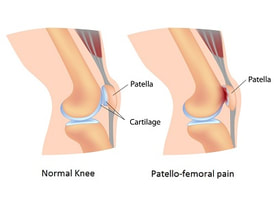|
Patellofemoral pain syndrome, often referred to as “runner’s knee”, is one of the most common causes of knee pain. PFPS is a common injury seen in adolescent athletes, particularly females. It is caused by an imbalance of forces placed through the patella, or kneecap. The amount of stress placed on the patellofemoral joint varies during certain activities, ranging from about ⅓ to ½ of body weight during walking, 3 times body weight with stair climbing, 5 to 6 times body weight with running, and up to 7 times body weight with squatting. As you can imagine, there is a good amount of running and squatting involved in cheer and this places athletes at an increased risk of developing PFPS. Risk Factors for Developing PFPS
Any of these factors alone could cause an athlete to develop PFPS, however if multiple of these factors are at play, that further increases the likelihood of the athlete developing PFPS. The good news is that many of these factors are preventable and/or fixable. Symptoms of PFPS
Treatment of PFPS
Physical therapy is a key component in recovering from PFPS. A physical therapist will evaluate you to help determine what the cause or causes are and then develop an individualized program to address these factors. Some of the common treatment activities include:
Prevention of PFPS While PFPS is usually easily resolved with physical therapy, there is a high chance that it can recur, or come back, unless changes to your training are made.
2 Comments
8/11/2020 02:52:09 am
I think that an injury like this is important. I know that there are people who have no idea what injury means, and that is fine. I work in the health care industry, which is why I need to be knowledgeable about them. To be fair, it does not really matter whether you work there or not. Everyone needs to get better at knowing stuff and just being able to adapt whenever there comes a time that we might need them.
Reply
Leave a Reply. |
Archives
April 2022
Categories
All
Disclaimer: The information contained on this website is compiled from a variety of professional sources as well as the author's own experiences. The information should NOT be used in place of a visit to your healthcare provider or used to disregard any advice provided by your healthcare provider.
|



 RSS Feed
RSS Feed